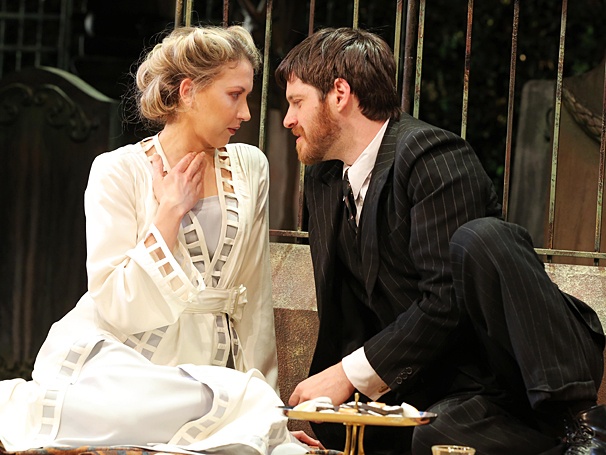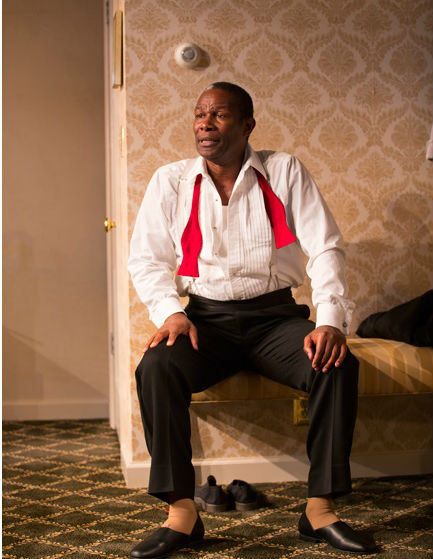In today’s Wall Street Journal drama column I review two New York openings, Aladdin and Tales from Red Vienna. Here’s an excerpt.
* * *
Disney Theatrical Productions turned six Disney films into Broadway musicals between 1994 and 2012. All were successful in varying degrees, and two of them, “The Lion King” and “Newsies,” are still running. If money makes your world go round, that’s an impressive track record. If, on the other hand, you’re more interested in artistic quality, then you may take a dimmer view of Disney’s continuing presence on Broadway. The best of the Disney shows, Julie Taymor’s 1997 stage version of “The Lion King,” is a minor masterpiece of creative design, while the worst, “Tarzan,” was as forgettable as a bad novel written in invisible ink. “Aladdin,” which is based on the 1992 animated feature, falls roughly halfway between those two stools. It’s not nearly as good as the movie, but it does have a terrific star, super-duper sets and sensational special effects.
Billing notwithstanding, the real star of “Aladdin” is James Monroe Iglehart, who plays the guy in the lamp, a part that was voiced in the movie by Robin Williams at his most frenetic. Mr. Iglehart is just as energetic, though his approach is different: His Genie is a hopped-up cross between Fats Waller and Cab Calloway. (Not surprisingly, he looks stupendous in an aquamarine zoot suit.) “Friend Like Me,” his big first-act number, comes within a cat’s whisker of stopping the show. The trouble is that nothing else in the first act can touch it. Adam Jacobs and Courtney Reed, who play Aladdin and his princess, are pretty but bland, and the temperature doesn’t start rising again until the magic-carpet ride, which comes after intermission and is the slickest thing to hit Broadway since the flying car in “Chitty Chitty Bang Bang.” From then on, “Aladdin” becomes fun and stays that way.
Even the best parts of “Aladdin,” however, are undercut by Chad Beguelin’s book, which is exactly funny enough to make a eight-year-old laugh….
 Nina Arianda is one of the most charismatic actors to make her New York debut in recent years–maybe ever. She’s only appeared in two plays, David Ives’ “Venus in Fur” and the unsuccessful 2011 Broadway revival of “Born Yesterday,” opting instead for smallish, presumably well-paid parts in film and on TV, but her slightly irregular good looks have doubtless prevented her from ascending to the upper tier of screen stardom, where facial symmetry is the summum bonum. So now she’s back on Off Broadway, playing a role in David Grimm’s “Tales from Red Vienna” that bears a distant family resemblance to the one in “Venus in Fur” that brought her to the attention of every critic in town. This time around, she’s a Viennese widow who comes from upper-middle-class stock but is forced by poverty to walk the streets, in which capacity she falls in love with a client, a journalist (Michael Esper) with whom she has wild and crazy sex.
Nina Arianda is one of the most charismatic actors to make her New York debut in recent years–maybe ever. She’s only appeared in two plays, David Ives’ “Venus in Fur” and the unsuccessful 2011 Broadway revival of “Born Yesterday,” opting instead for smallish, presumably well-paid parts in film and on TV, but her slightly irregular good looks have doubtless prevented her from ascending to the upper tier of screen stardom, where facial symmetry is the summum bonum. So now she’s back on Off Broadway, playing a role in David Grimm’s “Tales from Red Vienna” that bears a distant family resemblance to the one in “Venus in Fur” that brought her to the attention of every critic in town. This time around, she’s a Viennese widow who comes from upper-middle-class stock but is forced by poverty to walk the streets, in which capacity she falls in love with a client, a journalist (Michael Esper) with whom she has wild and crazy sex.
That’s not a wholly hopeless plotline, but Mr. Grimm, whose knowledge of Viennese culture circa 1920 appears to derive from the World Book, uses it as the basis for a two-and-a-half-hour play in which everybody talks like it’s 2014. (My jaw bounced off the floor when one of the actors uttered the word “stiffy.”) Ms. Arianda is as hot as ever, but her speech and stage presence are so unambiguously contemporary that it’s impossible to believe in the reality of her character…
* * *
Read the whole thing here.
Archives for March 21, 2014
Rave on
 Today’s New York Times contains an enthusiastic review of Satchmo at the Waldorf:
Today’s New York Times contains an enthusiastic review of Satchmo at the Waldorf:
There is a wonderful Milt Hinton photograph of Louis Armstrong in 1954, standing by his beloved reel-to-reel tape recorders, which he took with him everywhere to record performances and memories. It’s this Armstrong–relaxed, intimate and gregarious–that John Douglas Thompson vividly resurrects in Terry Teachout’s “Satchmo at the Waldorf,” a one-man show at the Westside Theater….
Mr. Teachout, The Wall Street Journal’s drama critic, is an Armstrong biographer, and Mr. Thompson–who appeared in productions of “Satchmo” at the Long Wharf Theater and Shakespeare & Company–certainly knows these characters. As directed by Gordon Edelstein, Mr. Thompson offers dazzling arias, at one point toggling between Armstrong and Glaser in a bravura pyrotechnical display. By the show’s end, you sense the profound fortitude that lay beneath the avuncular surface of this giant, and you are newly appreciative of his singular place in history.
On Wednesday John had to miss both performances owing to a pinched nerve. Michael Early, John’s understudy, covered for him, carrying a script (he hasn’t had time to learn the entire play yet). The New Yorker was there:
With so little stage business to ornament the action, and no chemistry generated by other actors, it’s the kind of distilled performance that thrills and terrifies, or obviously falters. Early was mellowly authoritative–he improvised, as Armstrong would have, when he couldn’t quite get back to the script in time. Though he had to turn the pages, the act seemed synonymous with Armstrong’s searching through the catalogue of his memories. At the end, the audience shouted and applauded with real feeling, and when Early took a bow he shared with us a look of relief. We’d all participated in a delightful pact: we’ll watch you catch this curveball, you’ll pretend like catching it is nothing….
For the record, John returned to the show last night, but it’s nice to know that he’s very well covered in case things go wrong.
Almanac: Thomas Mann on modesty
“I was at a party at William Dieterle’s house which Thomas Mann attended. Also present were a few Hollywood screenwriters–the sort who decided they were the Great American Novelist, but for the moment they were hoping for better things. One of them came up to Thomas Mann and almost bowed as he moaned, ‘How can a wonderful writer like you even talk to miserable whores like us?’ Mann looked at him for a second and said, ‘My dear sir, you are not big enough to make yourself so small.'”
Bernard Herrmann (quoted in Steven C. Smith, A Heart at Fire’s Center)
